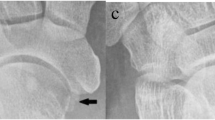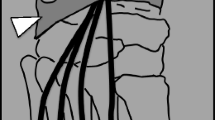Abstract
Objective
Our primary aim was to quantify the posterior tibial tendon (PTT) sheath fluid volume in individuals with the clinical diagnosis of stage 1 posterior tibial tendon dysfunction (PTTD) and no MRI-detectable intra-substance tendon pathology and compare them with patients with other causes of medial ankle pain, also without MRI-detectable intra-substance PTT pathology and with normal controls. We also wanted to determine if there is a fluid measurement that correlates with the clinical diagnosis of PTTD.
Materials and Methods
A total of 326 individuals with medial ankle pain and no intra-substance PTT pathology were studied. Group 1 included 48 patients with a clinical diagnosis of stage 1 PTT dysfunction, group 2 comprised 278 patients with other causes of medial ankle pain, and a third control group consisted of 56 patients without any medial ankle pain. MRI-based geometric measurements included PTT fluid volume, maximum cross-sectional fluid area, and fluid width. Fluid measurements were compared between groups and measurement reliability was tested.
Results
Group 1 showed greater PTT fluid volume, area, and width compared with groups 2 (other causes of medial ankle pain) and 3 (asymptomatic controls) (all p values < 0.001). A 9-mm threshold maximum fluid width was associated with PTTD (sensitivity 84%, specificity 85%). Measurements were reliable (all p values < 0.03) among three observers blinded to the gold standard.
Conclusion
Patients with stage 1 PTT dysfunction displayed greater volumes of tendon-sheath fluid than those with other causes of medial ankle pain and compared with asymptomatic controls. A threshold maximum fluid width greater than or equal to 9 mm distinguishes those with PTTD. An association between tendon sheath fluid distension and the clinical diagnosis of stage 1 posterior tibial tendon disease in the setting of no MRI-detectable intra-substance tendon pathology may allow for differentiation of medial ankle pain from other sources and may allow for early intervention aimed at preventing progressive PTTD. The level of evidence was prognostic (level III).



Similar content being viewed by others
References
Chhabra A, Soldatos T, Chalian M, et al. 3-Tesla magnetic resonance imaging evaluation of posterior tibial tendon dysfunction with relevance to clinical staging. J Foot Ankle Surg. 2011;50:320–8. https://doi.org/10.1053/j.jfas.2011.02.004.
Collins MS, Felmlee JP. 3T magnetic resonance imaging of ankle and hindfoot tendon pathology. Top Magn Reson Imaging. 2009;20:175–88. https://doi.org/10.1097/RMR.0b013e3181d47fbd.
Schweitzer ME, Karasick D. MR imaging of disorders of the posterior tibialis tendon. AJR Am J Roentgenol. 2000;175:627–35. https://doi.org/10.2214/ajr.175.3.1750627.
Schweitzer ME, van Leersum M, Ehrlich SS, Wapner K. Fluid in normal and abnormal ankle joints: amount and distribution as seen on MR images. AJR Am J Roentgenol. 1994;162:111–4. https://doi.org/10.2214/ajr.162.1.8273647.
Bare AA, Haddad SL. Tenosynovitis of the posterior tibial tendon. Foot Ankle Clin. 2001;6:37–66.
Trnka HJ. Dysfunction of the tendon of tibialis posterior. J Bone Joint Surg Br. 2004;86:939–46.
Pomeroy GC, Pike RH, Beals TC, Manoli A 2nd. Acquired flatfoot in adults due to dysfunction of the posterior tibial tendon. J Bone Joint Surg Am. 1999;81:1173–82.
Teasdall RD, Johnson KA. Surgical treatment of stage I posterior tibial tendon dysfunction. Foot Ankle Int. 1994;15:646–8. https://doi.org/10.1177/107110079401501203.
DeOrio JK, Shapiro SA, McNeil RB, Stansel J. Validity of the posterior tibial edema sign in posterior tibial tendon dysfunction. Foot Ankle Int. 2011;32:189–92. https://doi.org/10.3113/fai.2011.0189.
Nazarian LN, Rawool NM, Martin CE, Schweitzer ME. Synovial fluid in the hindfoot and ankle: detection of amount and distribution with US. Radiology. 1995;197:275–8. https://doi.org/10.1148/radiology.197.1.7568837.
Rosenberg ZS. Chronic rupture of the posterior tibial tendon. Magn Reson Imaging Clin North Am. 1994;2:79–87.
Khoury NJ, el-Khoury GY, Saltzman CL, Brandser EA. MR imaging of posterior tibial tendon dysfunction. AJR Am J Roentgenol. 1996;167:675–82. https://doi.org/10.2214/ajr.167.3.8751680.
Premkumar A, Perry MB, Dwyer AJ, et al. Sonography and MR imaging of posterior tibial tendinopathy. AJR Am J Roentgenol. 2002;178:223–32. https://doi.org/10.2214/ajr.178.1.1780223.
Otis JC, Deland JT, Kenneally S, Chang V. Medial arch strain after medial displacement calcaneal osteotomy: an in vitro study. Foot Ankle Int. 1999;20:222–6. https://doi.org/10.1177/107110079902000403.
Nallamshetty L, Nazarian LN, Schweitzer M, et al. Evaluation of posterior tibial pathology: comparison of sonography and MR imaging. Skeletal Radiol. 2005;34:375–80. https://doi.org/10.1007/s00256-005-0903-1.
Kulig K, Pomrantz AB, Burnfield JM, et al. Non-operative management of posterior tibialis tendon dysfunction: design of a randomized clinical trial [NCT00279630]. BMC Musculoskelet Disord. 2006;7:49. https://doi.org/10.1186/1471-2474-7-49.
Conti S, Michelson J, Jahss M. Clinical significance of magnetic resonance imaging in preoperative planning for reconstruction of posterior tibial tendon ruptures. Foot Ankle. 1992;13:208–14.
Alvarez RG, Marini A, Schmitt C, Saltzman CL. Stage I and II posterior tibial tendon dysfunction treated by a structured nonoperative management protocol: an orthosis and exercise program. Foot Ankle Int. 2006;27:2–8. https://doi.org/10.1177/107110070602700102.
Kulig K,, Reischl SF, Pomrantz AB, et al. Nonsurgical management of posterior tibial tendon dysfunction with orthoses and resistive exercise: a randomized controlled trial. Phys Ther. 2009;89:26–37. https://doi.org/10.2522/ptj.20070242.
Kulig K, Lederhaus ES, Reischl S, Arya S, Bashford G. Effect of eccentric exercise program for early tibialis posterior tendinopathy. Foot Ankle Int. 2009;30:877–85. https://doi.org/10.3113/fai.2009.0877.
Author information
Authors and Affiliations
Corresponding author
Ethics declarations
Conflicts of interest
None of the authors has a conflict of interest.
Ethics approval
This retrospective study was approved by the institution’s ethics committee. All authors made substantial contributions to conception and design, and/or acquisition of data, and/or analysis and interpretation of data. Authors also participated in drafting the article and revising it critically for important intellectual content; and the authors gave final approval of the version to be submitted and any revised version.
Additional information
Publisher’s note
Springer Nature remains neutral with regard to jurisdictional claims in published maps and institutional affiliations.
Rights and permissions
About this article
Cite this article
Gonzalez, F.M., Harmouche, E., Robertson, D.D. et al. Tenosynovial fluid as an indication of early posterior tibial tendon dysfunction in patients with normal tendon appearance. Skeletal Radiol 48, 1377–1383 (2019). https://doi.org/10.1007/s00256-018-3142-y
Received:
Revised:
Accepted:
Published:
Issue Date:
DOI: https://doi.org/10.1007/s00256-018-3142-y




